
 DATA
DATA
INTERPRETATION
TESTS Unbeatable practice for numerical
and quantitative reasoning and problem
solving tests MIKE BRYON  Publishers note Every possible effort has been made to ensure that the information contained in this book is accurate at the time of going to press, and the publishers and authors cannot accept responsibility for any errors or omissions, however caused. No responsibility for loss or damage occasioned to any person acting, or refraining from action, as a result of the material in this publication can be accepted by the editor, the publisher or the author. First published in Great Britain and the United States in 2009 by Kogan Page Limited Apart from any fair dealing for the purposes of research or private study, or criticism or review, as permitted under the Copyright, Designs and Patents Act 1988, this publication may only be reproduced, stored or transmitted, in any form or by any means, with the prior permission in writing of the publishers, or in the case of reprographic reproduction in accordance with the terms and licences issued by the CLA. Enquiries concerning reproduction outside these terms should be sent to the publishers at the undermentioned addresses:
Publishers note Every possible effort has been made to ensure that the information contained in this book is accurate at the time of going to press, and the publishers and authors cannot accept responsibility for any errors or omissions, however caused. No responsibility for loss or damage occasioned to any person acting, or refraining from action, as a result of the material in this publication can be accepted by the editor, the publisher or the author. First published in Great Britain and the United States in 2009 by Kogan Page Limited Apart from any fair dealing for the purposes of research or private study, or criticism or review, as permitted under the Copyright, Designs and Patents Act 1988, this publication may only be reproduced, stored or transmitted, in any form or by any means, with the prior permission in writing of the publishers, or in the case of reprographic reproduction in accordance with the terms and licences issued by the CLA. Enquiries concerning reproduction outside these terms should be sent to the publishers at the undermentioned addresses:
| 120 Pentonville Road | 525 South 4th Street, #241 |
| London N1 9JN | Philadelphia PA 19147 |
| United Kingdom | USA |
| www.koganpage.com |
Mike Bryon, 2009 The right of Mike Bryon to be identified as the author of this work has been asserted by him in accordance with the Copyright, Designs and Patents Act 1988. ISBN 978 0 7494 4970 4
British Library Cataloguing-in-Publication Data A CIP record for this book is available from the British Library.
Library of Congress Cataloging-in-Publication Data Bryon, Mike.
How to pass data interpretation tests : unbeatable practice for numerical and quantitative reasoning and problem solving tests / Mike Bryon. p. cm. ISBN 978-0-7494-4970-4 1. Psychometrics. 2.
NumeracyProblems, exercises, etc. 3. Employment tests I. Title. BF39.B78 2009 153.93--dc22 2009017478
Typeset by Saxon Graphics Ltd, Derby Printed and bound in India by Replika Press Pvt Ltd eBook by Graphicraft Limited, Hong Kong Contents This book provides everything you need for a successful programme of revision or review. It contains 330 practice questions with answers and explanations, advice on how to show your true potential and signposts to sources of further practice material.
Tests of data interpretation are fast becoming the most common type of psychometric test. They feature in the recruitment process for many positions in the professional services, finance, accountancy and graduate traineeships, and jobs including firefighter and many of those in the UK Civil Service. They can feature at any point in the process. In some instances they are taken online, often at the beginning of the recruitment process; in other instances they occur as a part of a battery of psychometric tests midway through the process. They also feature towards the end of some selection processes as a task at an assessment centre. In all instances they comprise a series of data sets drawn from almost any discipline to which a series of numeric questions relate.
It is your task to extract the appropriate data, demonstrate good judgement and undertake any necessary calculations in order to select the correct answer from the list of suggested answers. You will not find another book with so many practice questions on this subject, nor one so completely up to date and relevant to data interpretation tests used today. Uniquely, it offers 20 timed mini tests so that you can practise the all-important start to a data interpretation test and approach a real test with a new confidence.
We face psychometric tests at so many points in our career and their use is on the increase. Psychometric tests of your numerical skills are by far the most widespread type and data interpretation tests are fast becoming the most common sort of numerical test. They are administered at a computer terminal, online or with paper and pen.
The test may feature as a standalone assessment or one of a series of sub-tests taken one after the other. Nowadays the majority of recruitment processes will include a data interpretation test. These tests present you with a series of sets of data made up of, for example, a table, passage, graph or chart. The subject of the majority of these data sets will relate to the workplace and to business. However, expect the unexpected, because the subject can be drawn from every and any discipline. In many instances the data comprise a multiple of data sets and in many instances a passage of information setting the context.
In some tests the amount of data presented is extensive and much is irrelevant, so you must filter through the material quickly to find the relevant items. Every set of data is followed by a series of questions, each with a list of suggested answers. You have to sift through this information, combining relevant data from the respective sources, and select one of the suggested answers. In order to identify the correct answer you have to demonstrate good judgement and undertake calculations. You are expected to answer the questions using only the information contained in the data set. Be careful if you know something about the subject or if you believe the data to be factually incorrect, controversial or out of date.
It is not a test of your general knowledge, your knowledge of the last findings in the discipline or your political views. So feel completely as ease about answering a question using the data provided, even if you believe they are false given what you learnt at university or read in a newspaper that morning. If you face a data interpretation test online or administered at a computer screen then be aware that diagrams on the computer screen can sometimes appear misleading, especially in the case of geometric shapes, tables and graphs, as the screen in some instances can distort the image or the scale or both! The test author is aware of this and will have provided sufficient information to arrive at the answer. So if you are unlucky enough to find a distorted image or find its scale hard to read then rely on the written information and avoid drawing unnecessary assumptions about the appearance of a diagram, table or graph on the screen. For example, if a shape is described as a cube but on the screen the sides do not all seem equal, ignore it and treat the shape as a cube. Equally, if a table or graph says that quantity x is the largest but on the screen it looks like quantity y is the same or in fact bigger, take no notice and treat quantity x as the largest.
If until now you have struggled with maths and you have to pass such a test to realize your career or educational goal then it is time to get down to some serious score-improving practice. Everyone can rise to the challenge and master these questions some have to practise more than others. A few will have to show a great deal of determination and work very hard. This book is suitable for all levels from intermediate to advanced. You will find hundreds more practice questions in the following titles from the Kogan Page testing series: More at the intermediate level: The Numeracy Test Workbook Ultimate Psychometric Tests The Verbal Reasoning Test Workbook How to Pass Diagrammatic Reasoning Tests At the advanced level: How to Pass Advanced Numeracy Tests, Revised Edition How to Pass Graduate Psychometric Tests, 3rd Edition The Graduate Psychometric Test Workbook The Advanced Numeracy Test Workbook, 2nd Edition How To Pass Advanced Verbal Reasoning Tests If you face a data interpretation test as a part of a recruitment process then expect lots of other people to have applied also. In these circumstances treat the test as a competition and set out to achieve the best score possible.



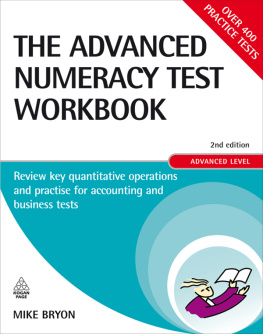
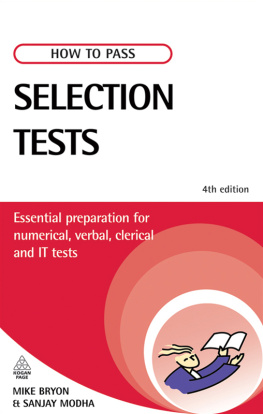

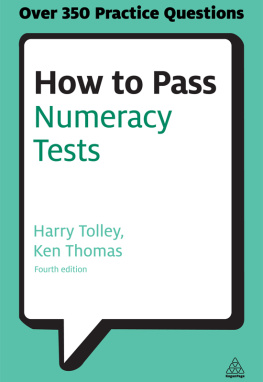
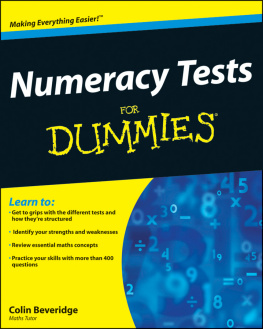

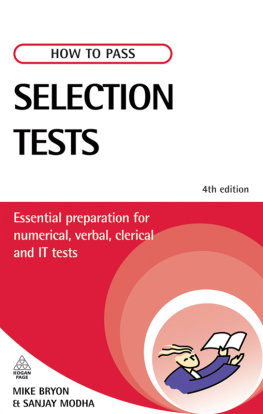

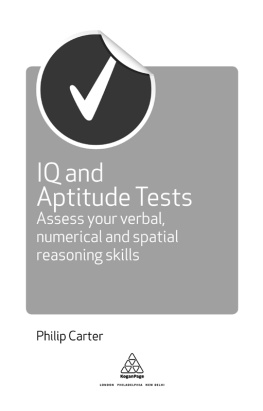



 DATA
DATA Publishers note Every possible effort has been made to ensure that the information contained in this book is accurate at the time of going to press, and the publishers and authors cannot accept responsibility for any errors or omissions, however caused. No responsibility for loss or damage occasioned to any person acting, or refraining from action, as a result of the material in this publication can be accepted by the editor, the publisher or the author. First published in Great Britain and the United States in 2009 by Kogan Page Limited Apart from any fair dealing for the purposes of research or private study, or criticism or review, as permitted under the Copyright, Designs and Patents Act 1988, this publication may only be reproduced, stored or transmitted, in any form or by any means, with the prior permission in writing of the publishers, or in the case of reprographic reproduction in accordance with the terms and licences issued by the CLA. Enquiries concerning reproduction outside these terms should be sent to the publishers at the undermentioned addresses:
Publishers note Every possible effort has been made to ensure that the information contained in this book is accurate at the time of going to press, and the publishers and authors cannot accept responsibility for any errors or omissions, however caused. No responsibility for loss or damage occasioned to any person acting, or refraining from action, as a result of the material in this publication can be accepted by the editor, the publisher or the author. First published in Great Britain and the United States in 2009 by Kogan Page Limited Apart from any fair dealing for the purposes of research or private study, or criticism or review, as permitted under the Copyright, Designs and Patents Act 1988, this publication may only be reproduced, stored or transmitted, in any form or by any means, with the prior permission in writing of the publishers, or in the case of reprographic reproduction in accordance with the terms and licences issued by the CLA. Enquiries concerning reproduction outside these terms should be sent to the publishers at the undermentioned addresses: